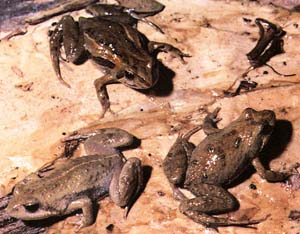Family Myobatrachidae, Genus Crinia
Referred to in 1991 by Frogwatch Field Guide to Victorian Frogs and other texts as the genus Ranidella, these frogs have been returned to the genus Crinia. These frogs are small terrestrial species found in all but the most arid regions of Australia. The eggs are laid in water either singly or in small jelly clumps and usually sink to the bottom. At least one species is known to breed all year round, and large congregations of calling males can often be found around temporary pools.
Characteristics of the Victorian members of the genus are horizontal pupil, indistinct tympanum, toes without webbing, belly wither moderately or heavily granular, mottled, flecked or peppered with black, brown or grey-blue on white, muddy white or grey. Back usually with ridges or at least a few slightly raised warts.
Accurate identification of the Victorian species is best done by use of the male's advertisement call.
 Two species, Crinia signifera
and Crinia parinsignifera, can show a variety of dorsal (back) patterns
or morphs. Three patterns are commonly recognised: [1] ridged (longitudinal
ridges along back); [2] lyrate (boomerang shaped ridges over the shoulder
and on the back); and [3] smooth (back smooth, unpatterned, or with small
warts). The image shows these three patterns on Crinia signifera (from
top in clockwise direction: [1],[2],[3]).
Two species, Crinia signifera
and Crinia parinsignifera, can show a variety of dorsal (back) patterns
or morphs. Three patterns are commonly recognised: [1] ridged (longitudinal
ridges along back); [2] lyrate (boomerang shaped ridges over the shoulder
and on the back); and [3] smooth (back smooth, unpatterned, or with small
warts). The image shows these three patterns on Crinia signifera (from
top in clockwise direction: [1],[2],[3]).
Identifying Crinia species
Question 18
![]() Belly
coarsely mottled in black and white or black and muddy white.
Belly
coarsely mottled in black and white or black and muddy white.

- Go to: Common Froglet, Crinia signifera
![]() Belly pale grey, muddy
white or white with fine black, grey or brown flecks.
Belly pale grey, muddy
white or white with fine black, grey or brown flecks.
- Go to: Question 19
Question 19
![]() Belly
light grey or muddy white, pepper with black, grey or brown flecks. Back
without small orange-capped warts.
Belly
light grey or muddy white, pepper with black, grey or brown flecks. Back
without small orange-capped warts.

- Go to: Plains Froglet, Crinia parinsignifera
![]() Belly
white or light grey scattered with grey-blue flecks forming loose clusters.
Back with small orange-capped warts.
Belly
white or light grey scattered with grey-blue flecks forming loose clusters.
Back with small orange-capped warts.

- Go to: Sloane's Froglet, Crinia sloanei

